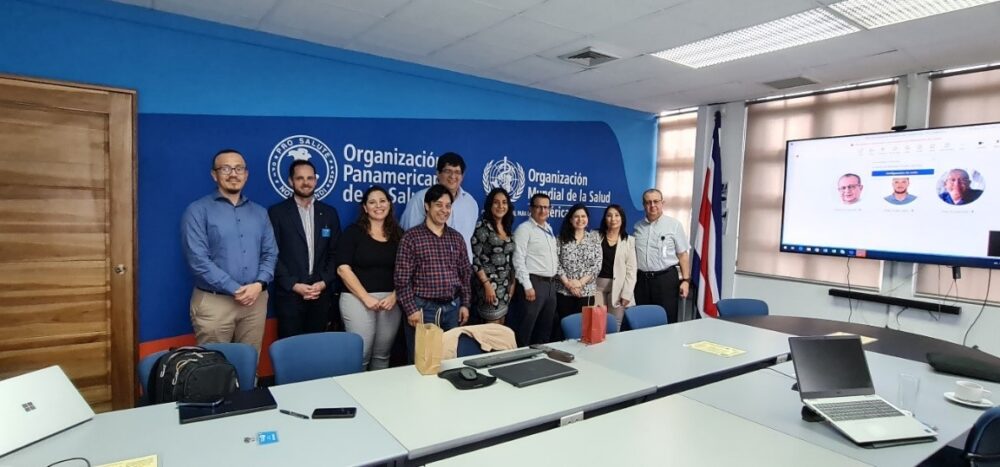
Costa Rica strengthens its respiratory virus surveillance system as a key country in the PIP Framework
Leading the PIP Framework in Costa Rica
Costa Rica is positioned as one of the key beneficiaries of the Pandemic Influenza Preparedness (PIP) Framework, a global initiative coordinated by the World Health Organization (WHO). This framework aims to improve preparedness, surveillance, and response capacities for influenza pandemics by providing financial and technical resources to strengthen both health infrastructure and national response capabilities.
As part of the PIP Framework 2024-2025 work plan, PAHO organized a technical mission from February 13-15, 2024, in Costa Rica. This mission stood out as a successful example of interdisciplinary collaboration, integrating the support of specialists in epidemiology, laboratory, and information systems to strengthen public health capacities in the country. The objectives covered were: 1) monitoring PIP Framework activities, 2) analyzing a suspected case of Influenza A H3v in Costa Rica, and 3) developing the IT interface for FluNet and FluID to optimize reports to PAHO/WHO.
During this mission, PAHO representatives worked closely with colleagues from the Ministry of Health, the Costa Rican Social Security Fund (CCSS), and the Costa Rican Institute for Research and Teaching in Nutrition and Health (INCIENSA).
Implementing the PIP 2024-2025 Framework in Costa Rica
Costa Rica reaffirmed its commitment to the Pandemic Influenza Preparedness (PIP) Framework 2024-2025, focusing on strengthening: 1) policies and plans, 2) collaborative surveillance through laboratory capacity and resilient surveillance systems via GISRS, 3) community protection, and 4) access to countermeasures.
During the recent review of the work plan, the importance of a comprehensive and coordinated approach to improving pandemic preparedness was emphasized. Key actions highlighted include the need for the Ministry of Health to maintain strong leadership in the execution of the plan’s activities and the updating of the Pandemic Preparedness and Response Plan for respiratory pathogens, ensuring an operational, multisectoral, and multilevel approach.
Recommended actions for countries:
- Facilitate early warning through resilient surveillance systems strengthened by National Influenza Centers (NIC).
- Update pandemic preparedness and response plans for pathogens in an integral, multisectoral, and multilevel manner.
Analyzing a suspected influenza A(H3v) case
In response to the country’s request for support, PAHO conducted an early action review (EAR) of a suspected case of Influenza A(H3v). This process revealed significant opportunities to improve multisectoral and multilevel coordination. Ultimately, the case was dismissed.
The implementation of the early action review (EAR) identified strategic opportunities to enhance early detection and rapid response to public health emergencies. Key areas highlighted to ensure timely detection and an effective response to epidemics and pandemics include: a) timely and appropriate sampling procedures; b) ensuring effective and timely sample transport, including during non-working hours and holidays; and c) strengthening the capacity for interpreting typing and subtyping tests across the country’s laboratory network.
Recommended actions for countries:
- Develop organizational charts to facilitate the recognition of actors and roles.
- Create information flows that simplify understanding and operation of processes.
Strengthening Interoperability to optimize the information system for respiratory virus surveillance and response
PAHO’s information systems specialists worked alongside the technology teams of the Ministry of Health, the CCSS, and INCIENSA to improve interoperability between national systems. Technical adjustments were made to the FluNet and FluID interfaces to optimize the country’s ability to share surveillance data promptly with PAHO and WHO.
The cooperation in implementing technical capacities for process automation between PAHO, the Ministry of Health, the CCSS, and INCIENSA has strengthened the country’s surveillance technological infrastructure, driving the modernization and standardization of data collection and transmission processes, which has improved system efficiency and continuous monitoring.
Recommended actions for countries:
- Invest in technological infrastructure to enhance real-time monitoring of respiratory viruses circulating both locally and globally.
- Strengthen collaboration across sectors to ensure efficient and effective information flow.
